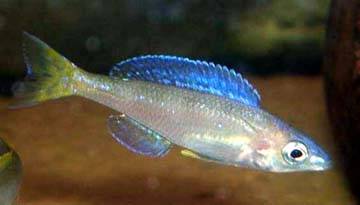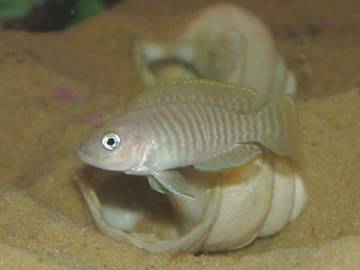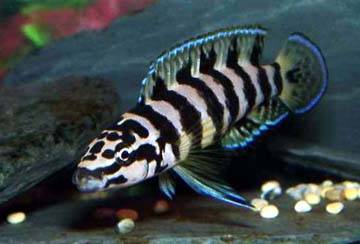Lake Tanganyika Cichlids
(this article was taken from former Aquarticles - free aquarium articles)
by Andy Gordon of England, and Michelle Stuart of Ontario Canada.
With photographs and contributions by Tom Hammond.
Lake Tanganyika is situated in the E. African Rift Valley in an area which has active volcanoes. This has affected the whole area and the water of the lake is very rich in minerals and quite alkaline. This must be taken in to account when planning to keep any fish from this lake.
There are three main biotopes within the lake itself:
- Open water with a sandy substrate.
- Rocky, found around parts of the shoreline and underwater reefs.
- Shell beds. Piles of empty snail shells found in various bays litter the floor.
Each biotope has attracted a different set of fish which has found ways to exploit that particular environment. The water quality remains the same throughout the lake - there may be one or two local variations where a river enters the lake but overall it is a very stable environment and the fish which have evolved there do not cope very well with sudden changes or poor water quality.
Care
Unlike the fish of Lake Malawi you cannot crowd these fish because their breeding strategy is entirely different. They require territories in which to breed, unlike the Malawi mouthbrooders. By carefully keeping fish from different niches and giving them what they require, you can keep a nice community; e.g. a large aquarium with a rock pile at one end a pile of shells at the other end and open water in-between will allow you to keep a good selection of compatible fish.
Water Chemistry
In order to keep these fish healthy the water chemistry is very important. There are still a lot of these fish coming in from the wild and they don’t have such a long history of being captive bred. Because of this it is important to ensure they are kept in the right water conditions:
- Ammonia: Nil
- Nitrite: Nil
- Nitrate: less than 20 ppm
- pH: 7.8 to 8.5
- GH: 12 to 20
- KH: 10 to 15
- Temp: 76°F to 80°F
Regular partial water changes are essential to keep the nitrates and other pollutants low, and the addition of trace elements is highly recommended. These fish will become weakened by a shortage of trace elements and could suffer ill health as a result.
Food and Feeding
The majority of the fish are micro-predators with the larger ones being true predators, although there are a few herbivores too. So make sure that you know the preference of the ones that you keep.
- Micro-predators : High protein pellets and flake. Live or frozen food of a suitable size.
- Herbivores: Low protein high fibre pellets and flake (goldfish food), cooked peas without skin, cucumber slices. Live/frozen food once per week.
Breeding
These fish are generally quite prolific and will spawn regularly if in good health and in good water quality. Some species are mouthbrooders and produce large well-developed fry, but only in small numbers - sometimes as few as four.
Open Water - By Tom Hammond
Distribution
Found mostly in the open water not far from the rocky habitat.

Cyprochromis photo by Tom Hammond
Species
The genus consists of Cyprichromis leptosoma, C. microlepidotus, C. pavo, C. sp. leptosoma jumbo and C. sp. "Zebra". C. leptosoma is the smallest of the genus, at a maximum of 4" for a male. The other species will get slightly larger, growing to 5". Claims have been made that C. sp. leptosoma jumbo will reach 7" but I have yet to see one above 5". There are colour variations in all species apart from C. sp. "Zebra". All bar C. sp. "Zebra" have at least two morphs within the same locality. For most species, it is the tail that will be either blue or yellow. But in C. pavo, it’s the anal fin that is either of the two colours. In C. sp. leptosoma jumbo from Kitumba, the body colour is also variable which creates scope for more variations. Males can be either all yellow (including tail), all blue (again including tail), blue body with a yellow tail or a mix of both blue and yellow with a yellow tail.
Maintenance
A large amount of open water is needed for the males’ three-dimensional territory. Males will rarely use the structure of the tank (rocks etc.) to mark out their territories; they just stay a certain distance from the surrounding males. I have successfully kept and bred C. leptosoma in a 24x15x12 tank, but the larger species will need more space. A 36x15x12 would be enough space for all species of Cyprichromis.
All Cyprichromis species are perfect candidates for a Tanganyikan community tank. This is because they occupy the open water, a niche which is rarely used by most other Tanganyikan cichlids. It is not recommended to keep Cyprichromis with hyperactive Aufwuchs grazers such Tropheus and Petrochromis. Cyphotilapia frontosa should not be included in a tank with Cyprichromis as the Cyprichromis are the natural diet of C. frontosa. At night, the frontosa will kill the resting fish.
Adequate filtration is a must, as like all Tanganyikan species, Cyprichromis demand excellent quality water. External canister filters are best in my opinion as waste is removed from the tank.
It is preferable to return the water from the filter through a spray bar, as it increases the amount of dissolved oxygen in the water. It will also create a good current around the tank, which these strong swimming fish seem to enjoy
As with all Tanganyikan cichlids, Cyprichromis require hard water with a pH of 8 or higher. Water should have 0 ammonia and 0 nitrite, and ideally less than 25ppm nitrate. A temperature of around 78°F is about right.
Males do not need any décor to mark out their territories, but females require plenty of cover in order to avoid the attention of the males. Plants are ideal for this purpose as they will become thick and dense. Substrate is a matter of choice. It is not needed for these fish, but a thin layer of sand will look more natural.
Some species (i.e. C. pavo) will display better colour in dim lighting. Bright light sometimes washes out the colour in the males.
I like to do reasonable sized water changes on all my fish. I do about 25 – 30% changes every week.
Breeding
Sexual differences
Males and females are easily told apart when adult due to the startling colour of the males, but sexing when young is not so easy. Depending on the situation, males may colour up at the 2" mark but it may well take longer, maybe nearer 3". Females will be a standard brown with the odd shimmer of colour (blue in many varieties of C. leptosoma). Females will also be ½ - 1" smaller than the males.
Breeding
Cyprichromis are a naturally grouping fish so it makes sense to keep them in such a group in the aquarium. In the lake, females and sub-dominant males form huge shoals numbering into the thousands; they are separate from the territorial males. Of course this is not possible in the aquarium, so the groups have to be scaled down. A good way to keep these fish is in multiple 1m. 2f. trios. This will spread out pressure from the males between a number of females, but a higher ratio of females to males will spread the pressure even more. Generally, the number of males depends on the size of the tank. A good rule of thumb for C. leptosoma is 1 male per foot of tank length, whereas the larger species require about 18" of tank length per male. Very domineering males will sometimes defend a territory up to 2 feet long.
If a female comes into spawning condition she will show a lot of interest in one of the males’ territories. Instead of hanging out with the rest of the shoal she will hover about in the centre of the chosen male’s territory. The males will immediately notice that she is ripe and will begin to court her. This involves showing her his fully outstretched fins. The female will also be shown his possible ‘egg dummies’ on the ends of his pelvic fins. Both of the pelvic fins will face the side of the body which the female is on; the male will vibrate them vigorously. This seems to be very alluring to the female. It is not known whether these ‘egg dummies’ are to show the female where to lay her eggs (i.e. in the centre of the male’s territory) or to stimulate the female into releasing her eggs. I believe it is a combination of the two.
In the event of the actual spawning, both fish will be hanging diagonally in the centre of the male’s territory. The male will be about 1.5" above the female. Something very curious is the fact that the male will protrude his jaws during the spawning process. I haven’t a clue why he does this but sure enough it happens on the spawning of every Cyprichromis species. Eggs will be released in batches of 2-3. Fertilisation takes place as the eggs are falling. The eggs will be caught by the female before they reach the substrate.
The eggs will then be carried for 17-25 days. In the first day or so after spawning, the mouth of the female looks huge but this bulge will go down after a while. This almost makes you think she has spat out the whole brood, but have faith, she’s just made room for the eggs to develop.
At about the 15 day mark, you will be able to see the developing fry clearly through the walls of her buccal cavity. Fry will usually be released within about an hour, being spat out in bursts of 2 or 3. For the first couple of hours, the fry will hang millimetres under the surface of the water. At this point they will be taking their first breaths of air, filling their swim bladders.
On release, fry will be about 0.5" long and can be fed newly hatched brine shrimp, frozen Cyclops and crushed flake food.
c. Tom Hammond 2003 All Rights Reserved
Shell Dwellers

Lamprologus multifasciatus photo by Tom Hammond
These fish are members of the Cichlid family and are one of the smallest of all known cichlids, growing only to about the size of a neon tetra. They are one of a group of fish that are called shell dwellers, because they live and breed in empty snail shells.
These fish are endemic to Lake Tanganyika in the East African Rift Valley and come from only one small area of the lake which is called Niamkolo Bay.
I initially bought six fish and placed them in a 24 x 12 x 12 which had just a mature sponge filter and about 18 large snail shells and a fine silica sand substrate about 1 inch deep. The water conditions were pH 8, GH 15, KH 12, and the temperature was 80 F.
The fish soon settled in and were fed on fine flake food and frozen Cyclops. Then the digging began. These fish are Olympic standard diggers: the first morning after getting them all the sand, (and I do mean ALL the sand), was piled up in one corner and they were all still busy taking sand from the bottom of the pile and placing it on top. I read in a book that the more shells there are the less they will dig. So I more than doubled the number of shells in the tank, but it made no difference at all. So I removed most of the sand and only left a thin layer on the floor. And this solved the problem.
It wasn’t long before the first fry appeared but only in very low numbers, from 1 to 4 in each brood. At first the fry could be seen swimming in the entrance of the shell, gradually venturing further and further out over 2 or 3 days. These tiny fry were left alone by all the adults and were tolerated in the spawning area even when there were younger fry around. This is because in the wild these fish live in colonies.
The fry were fed on powdered flake food which is sold for livebearer fry. They took to this food so well that I used it as their staple diet, for the adults to.
The number of fish in the tank soon grew to about 25 individuals, but never beyond this. I think (although I never witnessed it} that the dominant male of the group was responsible because there always seemed to be lots of fry of all sizes but never any more adults. They seemed to disappear once they reached adulthood, the males especially. But when I removed some the numbers were quickly made up.
If you are looking for something a little different and interesting you could do a lot worse than these fish. Although they live in a colony and tolerate each other, they should not be kept with other fish because they will aggressively defend their territory which seems to extend for about 1 foot with their shell in the middle. There is also the risk due to their small size of them being preyed upon.
Rocky Habitat

Julidochromis Gombi photo by Tom Hammond
Julidochromis
These fish are endemic to Lake Tanganyika in E. Africa. They live in very close association with rocks and seldom move more than a few inches away from them. Over generations this has lead to populations becoming isolated from each other and evolving separately. This has given rise to many closely related but separate species.
The water in Lake Tanganyika is very hard and alkaline. It is also very stable, and these are the conditions that these fish enjoy. They also strongly dislike each other’s company unless they are a mated pair, and even the pair bond can be easily upset. All it takes to upset the pair is to move some stones within their territory and they could end up fighting to the death.
Their care is quite easy. They should be kept in water that is pH 7.5 to 8.5, GH 15 or over, at a temperature of 76 to 80 F. They will eat all types of food and will thrive on a mixture of live or frozen, and flake food. If a few young fish are placed in the tank together, they will pair off on their own and claim small territories which they will defend vigorously. The females are much bigger than the males and are the dominant partner in the pair. I didn’t ever manage to witness them spawning. I did find some eggs though under a stone which had fallen over due to other fish digging around it, and the eggs are green.
These fish will spawn without any trouble if they are well looked after. They seem to find the most inaccessible space imaginable where they can barely squeeze in. The first I ever knew about it was when I could see the fry swimming very close to the rocks in their parents’ territory especially at feeding time. No special fry food was ever fed to the fry because my Julies were kept in quite a busy Tanganyikan community tank. I did notice on quite a few occasions that the parent fish would chew up some flake food and spit it out in the area that the fry were feeding, but I don’t know if this was a deliberate act or coincidence. Even under these conditions large numbers of fry grew to a saleable size.
When removing the fry it is a good idea to leave some with the parents or it may cause the pair to fight, and when these fish fight one is usually killed.
The young fish are tolerated within the adults’ territory until they start to become sexually mature, and then they are chased away. If you buy 6 fish and allow them to pair off, unless the tank is large enough to allow each pair to have separate territories the dominant pair will kill the others. If this is the case you must not intervene because the disturbance could cause the established pair to break up and there would be further bloodshed. It is better to let nature take its course, and any losses will very quickly be made up.
Fish, Tanks and Ponds 2002 - 2004 All Rights Reserved